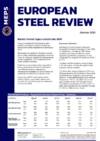European post-holiday steel market waiting for direction
Buying activity, in Europe, failed to recover to the anticipated extent, following the summer slowdown. Weakening transaction values and slightly improved availability clouded the future price direction, for all carbon steel products. Increased stock levels and the risk of holding expensive material, at the year-end, diminished buyers’ appetite for new purchases. European steel producers, however, attempted to hold their prices firm.
Negotiations, for half-yearly and annual supply to the automotive industry, commenced this month. European steelmakers are keen that these contracts incorporate the full increase achieved in the spot market, since summer 2020. To support this, they still quote extended delivery lead times, to other sectors. These stretch to December/January for hot rolled coils. Cold rolled and coated material is now offered for delivery in February 2022.
Auto production, however, is hampered by the semiconductor shortages. Several car manufacturers have announced stoppages, of varying lengths. Reduced activity, in this sector, may restrict contract price increases. It also improves spot availability in the general market.
Nominally attractive import offers, for Asian coil products, are exerting downward price pressure, in southern Europe. Quota restrictions, tariffs, high transport costs and a lack of port warehousing inflate apparent prices and limit interest for some buyers. Nonetheless, docks are reportedly holding extensive volumes of steel, notably Indian-origin coils. These will be customs cleared, in the EU and the UK, on October 1, 2021.
The introduction, in Russia, of an export tax, caused a rush to supply the domestic market. As a result, local prices collapsed. Russian hot rolled coil is now offered at very competitive prices, in Western Europe, inclusive of tax.
Mill deliveries to distributors continued throughout August. Downstream sales were largely halted. Furthermore, consumers have started to destock. Consequently, inventories at service centres are growing. This allows purchasers the luxury of delaying new decisions, waiting for the market direction to become clearer. Weakening international scrap and iron ore values are also creating hesitation.
The buoyant construction sector, good mill order books and elevated transport costs all point to further price rises. Safeguard mechanisms support mills’ pricing efforts. Carbon and ‘green’ steel surcharges are being gradually implemented. Transaction values, however, continued to decrease, after MEPS’ research was completed. This downward trend is expected to persist, in the near term.

Source:
European Steel Review
The MEPS European Steel Review is an informative, concise and easy-to-use monthly publication, offering unique professional insight into European carbon steel prices.
Go to productRequest a free publication





